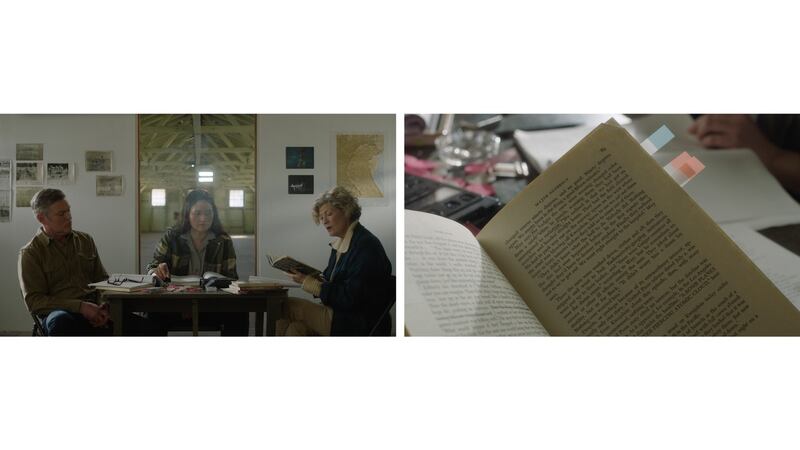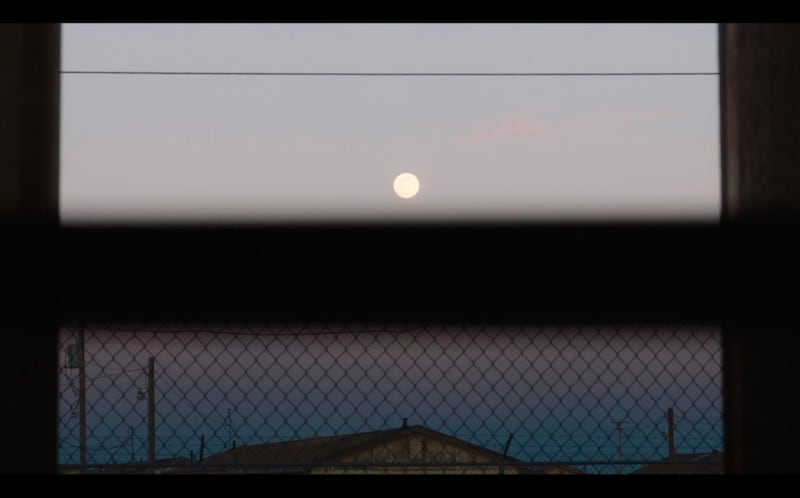13BC: FATAL ACT
Douglas Hyde Gallery, Trinity College Dublin, Until December 7th
★★★★☆
Where to begin with Fatal Act? The exhibition is dense with layers of historical and cultural reference, to an almost paralysing degree. Its creators, the moving image research collective 13BC (Vic Brooks, Lucy Raven and Evan Calder Williams), are so hyper-alert to coincidences, connections, parallels and ironies that they could be mistaken for conspiracy theorists, for whom every encountered piece of information fits into a grand, overarching pattern.
What might that overarching pattern involve in Fatal Act? Well, one central point of reference is an unmade film, Bob Hope’s unrealised proposal to produce a feature film based on the experiences of an officer in the US air force, Claude R Eatherly. During the second World War, Eatherly was a weather-monitoring pilot and, as such, gave the go-ahead for the bombing of Hiroshima. In the postwar years, his life unravelled. A series of self-defeating botched bank robberies (running, but neglecting to take the money), bounced cheques and nonsensical business schemes led him to stays in the Veterans Administration Hospital in Waco, Texas.
Post-traumatic stress disorder (PTSD) was not recognised as a condition at the time, and various theories were advanced to explain his erratic behaviour. While he was hospitalised in 1959, the German philosopher and anti-nuclear activist Günther Anders wrote to him with a novel theory: the issue was his involvement in the unthinkable project of nuclear annihilation, a step too far for human consciousness, and conscience. A correspondence developed between them, in the course of which Anders warned him off involvement in Bob Hope’s film. Instead of the terrible reality, Anders said, the film would spin a cosy narrative, reducing him to a formulaic character.
Bunker-like space
13BC replace a negative with their own negative. The unrealised Bob Hope film is echoed in the calculatedly unrealised Fatal Act, a composite of what might be described as four non-films, one of them twin-screen and, separately, a musical soundtrack and installation. The Douglas Hyde’s bunker-like space is well suited and well used as a venue for the project. Sounds, both spoken words and Jason Moran’s leisurely, meandering piano score, waft through the air. A glow of muted red light recalls a darkened cinema interior. Information is imparted obliquely and piecemeal.


The two-channel projection Straight Flush occupies the main gallery space and features three actors. Sitting around a table (the location was a disused air force base) they could be playing the parts of three actors going through the script for the unrealised Eatherly film. Except that roles, identities and narrative logic quickly become fluid and unreliable so that it’s impossible to pin down one coherent interpretation. That presumably has to do with 13BC’s rejection of the formulaic characters and cosy narratives that Anders warned Eatherly about. In fact, their antipathy to conventional representations of the nuclear age and other global threats is probably even greater than his. Incidentally, the disjunctures and slippages involved in the Straight Flush bring very much to mind the Brechtian alienation of Gerard Byrne’s dramatised reconstructions of historical media interviews, discussions and advertisements.
As the title Straight Flush hints, the table is littered with gambling paraphernalia, presumably because the air force base, and bomb test sites, were located in indigenous lands, as are many gambling casinos, as 13BC point out. Another strand of Fatal Act, Corpse Cleaner, elaborates on Anders’s warning about the film industry. It hinges on the fact that for a time in the early 1940s, in exile in California but classed as an “enemy alien”, he wrote a film script (again unmade) and worked as a janitor in a vast 12-storey prop warehouse. This prompts a continuous Steadicam tracking shot through a present-day prop repository, overlain by a commentary that muses on the artifice of film and, oddly, sneers superciliously at The Monuments Men, George Clooney’s film inspired by a book about the unit tasked with finding art looted by the Nazis in Europe following the Normandy landings. The tone of intellectual smugness evident here is not altogether absent elsewhere in Fatal Act.
Piano music
The piano music also takes its cue from Anders’s biography, the idea being that Jason Moran plays the role of Anders’ wife Charlotte Zelka, a professional pianist (they later separated). Moran’s keyboard contribution alludes to the modernist chamber music that Zelka performed, though her more immediate involvement with Eatherly’s story is that she typed Anders’s letter to him. There is more, quite a lot more, in the way of interconnections and digressions.
Does it all hang together, you might be tempted to ask?
Yes and no. Everything certainly connects in some way or another, but one presumes that in a way for 13BC the whole point is that it should not hang together as any form of conventional representational form. Theirs is a process of forensic research and systematic deconstruction. They are not about composing a conventional narrative account of the unlikely convergence of Anders and Eatherly and their respective backgrounds and histories, rather in mining the material to fuel an exploration of wider questions of continuing, perhaps even greater, relevance today.










